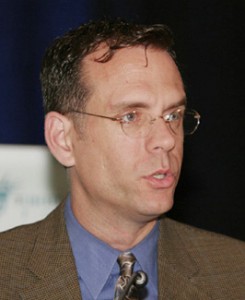OutRight: Check the Numbers
Does United ENDA represent the community?
In the recent debate over ENDA, it has frequently been said that “the community” solidly opposes the first-ever federal gay civil rights bill unless it includes transgenders.
The evidence for this surprising unity is the fact that more than 300 organizations have signed an online petition, available at www.UnitedENDA.org. “United ENDA,” the website boasts, “effectively communicated the strong opposition of hundreds of organizations and millions of members of the lesbian, gay, bisexual, and transgender community.”
The correctness of an all-or-nothing approach to civil rights is not determined solely by the number of organizations or people who favor or oppose it. The strategy could be wrong even if everybody supported it; conversely, it could be right even if everybody opposed it. But in a society that values representative politics, claiming that you speak for millions of people lends moral authority and democratic legitimacy to your cause.
So is it true that United ENDA speaks for the community? The answer depends on which “community” we mean. If we mean “the community of gay and trans activists” who lead organizations like the National Gay & Lesbian Task Force, the answer is “yes.”
This is a select group of people, however. They are very liberal, highly educated, and unusually politically aware. They long ago bought the idea that the “T” is necessarily part of the “GLB.” This view is strongly influenced by academic queer and gender theory that, whatever its merits, is probably not widely understood or actively embraced.
This does not mean that the leaders of these organizations are wrong; their dedication to their beliefs is admirable. It is only to suggest that they may not be representative.
But, it might be answered, they lead more than 300 organizations that collectively do represent millions of members of the community. To determine whether this might be true, I looked at the organizations listed on the United ENDA website. The list is much less impressive than it first seems.
Some of the groups are well-known players on the national stage, like NGLTF and Lambda Legal. The vast majority are very obscure local and state groups. One is called “Coqsure,” described online as a “social group” in Portland, Oregon, “for people who were born or raised female who don’t presently identify as totally female.”
Missing from the list is the largest and most influential gay political group, the Human Rights Campaign. There are no gay Republican organizations listed, yet more than 25 percent of gay people regularly vote Republican in national elections.
The list is padded. The National Stonewall Democrats are there, but so are a dozen of the group’s state and local chapters, including both the Colorado chapter and that chapter’s “Transgender Caucus.” The national PFLAG organization is listed, but so are half a dozen of its subsidiaries. On and on it goes like that.
The list also includes numerous nongay organizations, like the Alliance for Jewish Renewal and a single local chapter of the American Federation of Teachers. They’re free to oppose a bill that protects gay civil rights, of course, but they don’t represent the gay community.
There are about ten million gay Americans, of whom perhaps 7.5 million are adults. How many of them are “represented” by the United ENDA signatory groups?
One way to determine that is by asking how many active members the groups have. Unfortunately, membership figures are mostly unavailable and are often inflated when they are available, consisting of little more than a mailing list.
Membership in the listed organizations also overlaps. The active membership of most of these groups, especially the more than 70 transgender groups listed, is probably tiny. Even many of the gay groups aren’t very large. To take just one example, the Houston GLBT Political Caucus, “representing” gays in a metropolitan area of more than four million people, regularly gets fewer than 30 people at meetings.
Let’s assume very generously that the 300 groups average 1,000 non-overlapping members each. That’s a total of 300,000 people—well short of “millions” and less than five percent of the 7.5 million gay adults in the country.
Do the listed groups even represent their own members? A fascinating recent article in the Washington Blade about growing defections from the United ENDA front quoted gay Democratic activist Peter Rosenstein as saying that few of the 300 groups canvassed their members before taking a stand.
For example, Geoff Kors, head of Equality California, acknowledged that his group did not poll its members. But, he added, he had received lots of supportive e-mails. Getting e-mail from people who agree with you is not a vote.
United ENDA could assert that it speaks for many in the community who aren’t members of the signatory groups. The problem with that claim is that there are no reliable polls telling us how many gay people would forego their civil rights until “gender identity” is included.
More than two-thirds of the United ENDA signatories appear to be headquartered in states or cities where gay people are already protected from discrimination. I’m confident many members of the Harvard Transgender Task Force and the Alice B. Toklas LGBT Democratic Club of San Francisco fully support making gay people in Mississippi wait until ENDA is ideologically pure, but they don’t speak for anyone outside their privileged precincts.
In short, there is simply no good evidence for United ENDA’s claim that the community opposes an incremental approach to civil rights.
Writing from the conservative side, Dale Carpenter began his column for OutSmart in 1994, when he lived in Houston. Now residing in Minneapolis, Carpenter is a University of Minnesota Law School professor.











